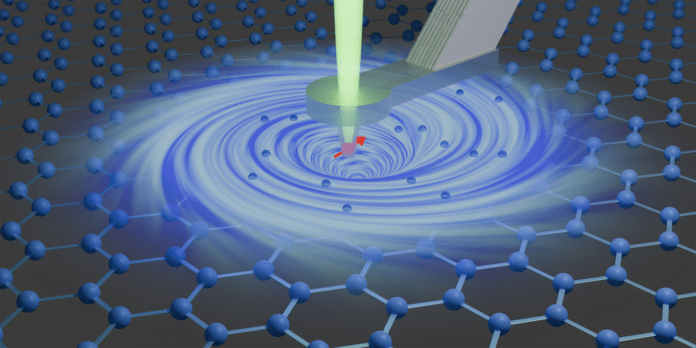
13 May, 2024 by Amit Malewar
Collected at : https://www.techexplorist.com/researchers-detect-electron-vortices-in-graphene/83727
Researchers at ETH Zurich have achieved a breakthrough by making visible how electrons form vortices in a material at room temperature. This is the first time such electron vortices have been detected at this temperature. The experiment used a quantum sensing microscope with an extremely high resolution.
In graphene, electrons behave like a liquid, which can lead to the formation of vortices. These vortices have now been made visible using a quantum magnetic field sensor with a high spatial resolution.
Typically, transport phenomena are more easily detected at low temperatures. However, thanks to their highly sensitive sensor, the ETH researchers could observe vortices even at room temperature.
The researchers used small circular disks attached during the fabrication process to a conducting graphene strip that was only one micrometer wide. The disks had different diameters, between 1.2 and 3 micrometers.
Theoretical calculations suggested that electron vortices should form in the smaller but not in the larger disks. To make the vortices visible, the researchers measured the tiny magnetic fields produced by the electrons flowing inside the graphene.
For this purpose, they used a quantum magnetic field sensor consisting of a so-called nitrogen-vacancy (NV) centre embedded in the tip of a diamond needle.
Using laser beams and microwave pulses, the quantum states of the centre can be prepared in such a way as to be maximally sensitive to magnetic fields. By reading out the quantum states with a laser, the researchers could determine the strength of those fields very precisely.
The researchers observed a characteristic sign of the expected vortices in the smaller discs: a reversal of the flow direction. While in normal (diffusive) electron transport, the electrons in strip and disc flow in the same direction, in the case of a vortex, the flow direction inside the disc is inverted. As predicted by the calculations, no vortices could be observed in the larger discs.
“Thanks to our extremely sensitive sensor and high spatial resolution, we didn’t even need to cool down the graphene and were able to conduct the experiments at room temperature,” says Marius Palm, a former PhD student in Degen’s group. Moreover, he and his colleagues not only detected electron vortices but also vortices formed by hole carriers.
“At this moment, the detection of electron vortices is basic research, and there are still lots of open questions,” says Palm. For instance, researchers still need to figure out how collisions of the electrons with the graphene’s borders influence the flow pattern, and what effects are occurring in even smaller structures.
The new detection method used by the ETH researchers also permits taking a closer look at many other exotic electron transport effects in mesoscopic structures – phenomena that occur on length scales from several tens of nanometres up to a few micrometres.
In conclusion, the discovery of electron vortices in graphene at room temperature is a significant milestone in the field of physics and material science. The achievement opens up new avenues for researchers to explore the behavior of electrons at a microscopic level. It may have exciting implications for the development of new technologies.
Journal Reference
- Palm M, Ding C, Huxter W, Taniguchi T., Watanabe K, Degen C: Observation of current whirlpools in graphene at room temperature. Science, 25. April 2024, DOI:10.1126/science.adj2167

Leave a Reply